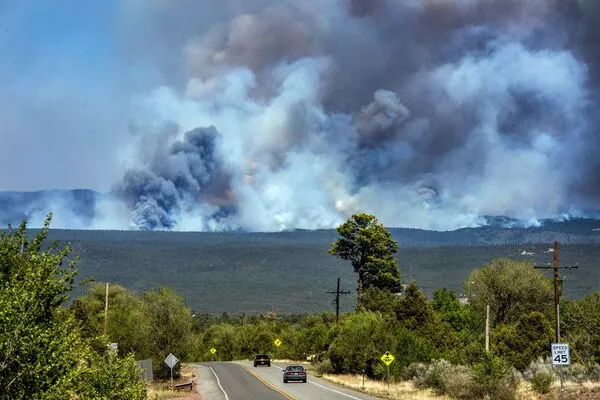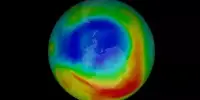Jessica Reeder and her son and daughter returned to Philadelphia from a relaxing day at the Jersey Shore last July. A hazy, yellow-gray sky greeted them as they crossed a bridge from New Jersey into Pennsylvania. Reeder was reminded of the smoky skies she used to see growing up in Southern California on days when fires raged in the dry canyons.
Reeder, sensing smoke and concerned about her asthma and her children, flipped the switch to recirculate the air inside the car rather than drawing from the outside. At home, the family shut all the windows and turned their air purifiers to maximum power.
The smoke had traveled from fires raging on the other side of the continent, in the western United States and Canada. Although air quality in Philadelphia was not as bad as in some Western cities, it was bad enough to warrant air quality warnings — and not just for people with asthma or heart problems.
The majority of major wildfires in the United States occur in the West. The smoke, however, does not remain. It moves eastward, affecting communities hundreds to thousands of kilometers away from the fires. According to a study published in September 2021 GeoHealth, the majority of asthma-related deaths and emergency room visits in the United States are attributed to fire smoke.
The main issue is fine particulate matter, or PM2.5, which are tiny particles. These ash, gas, and other detritus particles suspended in smoke are only 2.5 micrometers wide, small enough to lodge in the lungs and cause permanent damage. PM2.5 aggravates respiratory and cardiovascular problems and can cause death. In otherwise healthy adults and children, the particles can also cause asthma and other chronic conditions.
Over the last few decades, U.S. clean air regulations have cut down on particulate matter from industrial pollution, so the air has been getting cleaner, especially in the populous eastern cities. But the regulations don’t address particulate matter from wildfire smoke, which recent studies show is chemically different from industrial air pollution, potentially more hazardous to humans and increasing significantly.
The majority of major wildfires in the United States occur in the West. The smoke, however, does not remain. It moves eastward, affecting communities hundreds to thousands of kilometers away from the fires.
Rosana Aguilera
Much of the research on how wildfire PM2.5 can make people sick has so far focused on people who live or work near fires in the West. Researchers are now focusing on how PM2.5 from smoke affects major population centers in the East, far from the wildfires. One thing is certain: As the intensity and frequency of wildfires increase as a result of climate change, people across North America should be concerned about the health consequences, according to Katelyn O’Dell, an atmospheric scientist at George Washington University in Washington, D.C.
Bad air travels
PM2.5 emissions from exhaust-emitting cars and trucks, as well as fossil-fuel–burning factories and power plants, are limited by air pollution regulations. According to Rosana Aguilera, an environmental scientist at the Scripps Institution of Oceanography in La Jolla, California, these regulations have done “a really good job” of reducing anthropogenic air pollution in the last few decades. According to the US Environmental Protection Agency, concentrations of six of the most common air pollutants have decreased by 78% in the United States since the Clean Air Act of 1970. PM2.5 levels have also decreased — at least until recently.
Western wildfires are erasing some of the gains made in reducing industrial pollution, according to Rebecca Buchholz, an atmospheric chemist at the National Center for Atmospheric Research in Boulder, Colo.
Fires in the Pacific Northwest are “driving an upward trend” in particulate matter air pollution, according to Buchholz and colleagues in Nature Communications on April 19. Such smoke pollution peaks in August, when fires in the region are at their peak and the atmosphere’s ability to clean itself through natural processes such as rain is limited. According to Buchholz, this late-summer spike in air pollution is unprecedented. It’s been particularly noticeable since 2012.

Furthermore, as Reeder and her family discovered last year, transported wildfire pollution is causing significant particulate matter spikes in the central United States and northeastern North America, according to Buchholz and colleagues. As a result, Pacific Northwest wildfires “have the potential to impact surface air quality, even at great distances downwind of the wildfires,” the team wrote, putting some 23 million people in the central United States and 72 million in northeastern North America at increased risk of health effects from imported wildfire smoke.
How far and where PM2.5 travels depends on weather patterns and how high wildfire smoke reaches — the stronger the fire, the longer it can last and the farther smoke can go, and thus the farther particulate matter can reach. Last year, far-away wildfires created unhealthy air quality conditions in locations from the Great Plains to New York City and Washington, D.C.
Human impacts
According to O’Dell, lead author of the 2021 GeoHealth study, smoke in the West is already having a tangible effect on human health in the East. O’Dell and colleagues discovered that more people in the East than in the West visit emergency rooms and are hospitalized for asthma problems caused by PM2.5 in smoke from 2006 to 2018. In 11 of the 13 years studied, asthma-related ER visits and hospitalizations were higher east of the Rockies.
During the study period, an average of 74% of asthma-related deaths and 75% of asthma ER visits and hospitalizations were attributable to smoke east of the Rockies. Of the estimated 6,300 excess deaths from asthma complications due to smoke PM2.5 that occurred annually over the study period, more than 4,600 were in the East.
Smoke affects so many more people in the East, primarily because there are so many more people there, according to O’Dell. Her team defined “West” as west of the Rockies, which has a population of 64 million, and “East” as east of the Rockies, which has a population of 226 million. Smoke PM2.5 causes a greater proportion of regional asthma deaths in the West. In the East, it is a smaller proportion of the total population, but there are far more people affected.
“We may already be seeing the effects of these fires on the health of residents hundreds, if not thousands, of miles away,” Buchholz said in a press release.
















